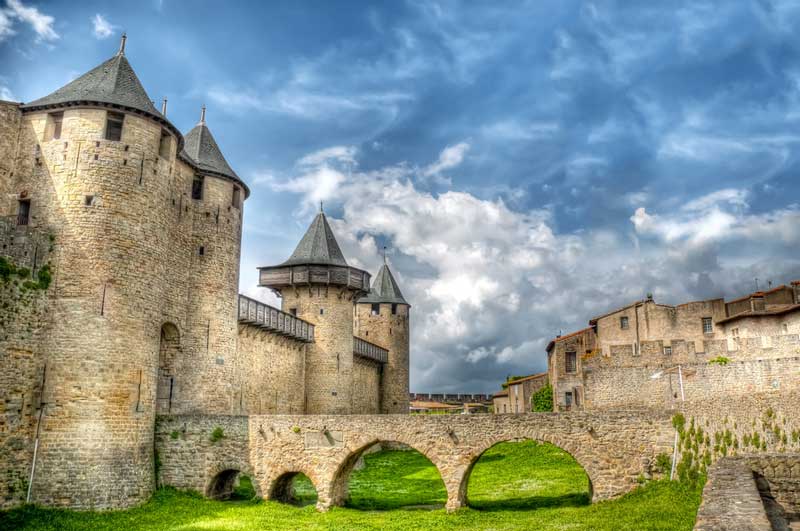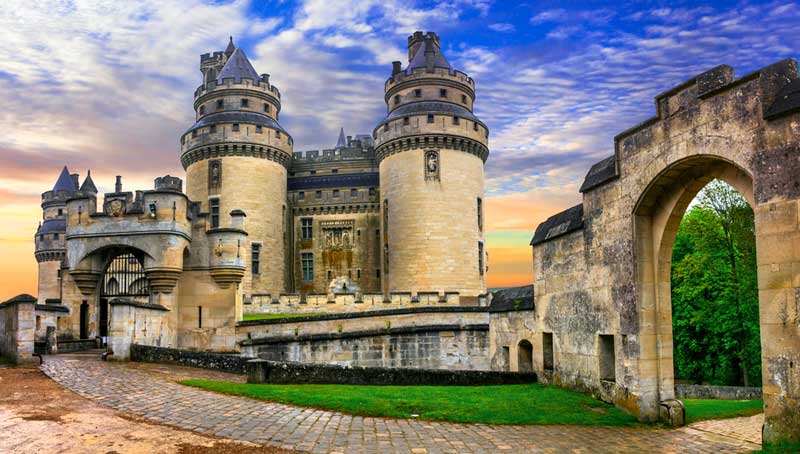France, with its rich history and architectural splendor, is home to over 45,000 breathtaking castles, many of which seem to come straight out of a fairy tale. They stand out for their historical and architectural significance.
These castles, ranging from medieval fortresses to opulent palaces, are spread across the nation, with some regions like the Dordogne and the Loire Valley boasting a rich concentration of these majestic structures.
These castles, from defensive fortifications to residences of refinement and aesthetics, mirror the evolution of French architecture and society.
They range from fortified castles with small windows and no pleasure gardens, reflecting their defensive purpose, to the light-filled Renaissance castles with ornamental gardens, and finally to the classic castles of the Henri IV and Louis XIII periods, characterized by large wooden windows and symmetrical facades surrounded by French gardens and lakes.
These castles are not just relics of the past; they are living stories, embodying the rich tapestry of French history and art. A visit to these castles is a journey through time, offering a glimpse into the lives of the nobility and the evolution of architectural styles over centuries.
Stunning French Castles
1. Château de Chenonceau

Château de Chenonceau
Château de Chenonceau, a remarkable structure spanning the Cher River, is renowned for its blend of late Gothic and Renaissance architectural styles. The château’s history is rich and dramatic, particularly under the ownership of Diane de Poitiers and Catherine de’ Medici.
Diane, the mistress of King Henry II, was responsible for the construction of the château’s iconic arched bridge and the beautiful gardens.
After Henry’s death, Catherine de’ Medici took over the château, making it her favorite residence and adding her own renovations, including a grand gallery that extends across the river. Chenonceau was not only a royal residence but also a place of refuge and resistance during World War II.
The château’s location on the demarcation line allowed it to be a passage for refugees and fighters. Today, visitors can explore its sumptuous rooms and the contrasting gardens of Diane and Catherine, along with enjoying the rich history and artistry it offers.
2. Château de Chaumont-sur-Loire

Château de Chaumont-sur-Loire
Perched atop a hill with a serene view of the Loire River, Château de Chaumont-sur-Loire is a splendid blend of Gothic and Renaissance architecture. Originally a 10th-century fortress, it has undergone various transformations, each adding to its rich historical tapestry.
The castle’s most intriguing history involves Catherine de Medici and Diane de Poitiers, whose fates intertwined within its walls. After King Henry II’s death, Catherine acquired Chaumont and exchanged it with Diane for the grander Château de Chenonceau.
Today, Chaumont-sur-Loire is famous for its International Garden Festival, attracting artists and designers globally. Visitors can explore the lush gardens, where history and contemporary art merge, offering a unique and enchanting experience.
3. Château de Vigny

Château de Vigny
Nestled in the Val-d’Oise department, the Château de Vigny is a Renaissance masterpiece, exuding grandeur and splendor. Built in the 16th century, it harmoniously combines Medieval and Renaissance architectural elements, complete with imposing circular towers and a moat.
The castle’s history is rich with tales of noble families and dramatic events, notably the tenure of Count Honoré d’Estienne d’Orves, a marshal and war hero. Vigny’s legend includes a masquerade ball where a mysterious lady in a silver mask left a haunting melody echoing through its halls.
Today, the château, having served various roles, remains a beacon of French heritage, inviting visitors to immerse themselves in its history and romance.
4. Château de Chambord

Château de Chambord
Château de Chambord is a magnificent example of French Renaissance architecture, rising majestically from the Loire Valley. Commissioned by King Francis I, it was designed more as a hunting lodge than a fortress. Its most striking feature is the double helix staircase, possibly influenced by Leonardo da Vinci.
The château’s silhouette, complete with intricate latticework and lofty towers, has inspired countless artists, including being a possible influence for the castle in “Beauty and the Beast”.
Beyond its architectural marvels, Chambord is filled with tales of royal intrigues and secret love letters, offering visitors a glimpse into the lavish lifestyle of the French aristocracy. Its legendary hidden chamber, if exists, remains a mystery, adding to the castle’s allure.
5. Château de Chantilly

Château de Chantilly
The Château de Chantilly, located near Paris in the lush forests of the Oise department, is a testament to the opulence of the French Renaissance. Dating back to the medieval period, its Renaissance additions have given it a distinct elegance.
The castle was significantly influenced by Henri d’Orléans, the Duke of Aumale, who was an avid art collector. He amassed one of the finest collections of paintings and manuscripts, rivaling even the Louvre.
The castle’s gardens, designed by the famous André Le Nôtre, are equally impressive, with legends of the “Moonlit Duchess” haunting its grounds. Today, Chantilly continues to captivate visitors with its rich history, magnificent art collection, and beautiful gardens.
6. Château des ducs de Bretagne

Château des ducs de Bretagne
The Château des ducs de Bretagne in Nantes, France, stands as a historical jewel. This castle, once the residence of the Dukes of Brittany, played a crucial role in the region’s politics and economy, especially during the Wars of Succession.
It’s a symbol of power and authority, deeply integrated into the history of Nantes. The castle underwent significant transformation during the Renaissance, adding architectural elegance to its fortified structure.
During the French Revolution, it served as a military base and prison, marking its importance in France’s tumultuous history. Today, after extensive restoration, it houses the Nantes History Museum, offering insights into the city’s past, present, and future.
The night-time illuminations and the walk on the fortified ramparts provide captivating views, making it a must-visit historical and cultural landmark.
7. Château de Haut-Kœnigsbourg

Château de Haut-Kœnigsbourg
The Château de Haut-Kœnigsbourg, nestled in the heart of Alsace, is a medieval castle dating back to the 12th century. Rebuilt in the early 1900s by German Kaiser Wilhelm II, this castle exemplifies medieval architecture and offers a panoramic view of the Alsace region.
With over 500,000 visitors a year, Haut-Kœnigsbourg has become a symbol of the region’s history and culture. The castle’s architecture, with its defensive structures and medieval charm, transports visitors back to a time of knights and feudal battles.
The restoration work by Wilhelm II aimed to return the castle to its former glory, reflecting a romanticized view of the medieval period. Haut-Kœnigsbourg stands as a testament to the enduring allure of medieval architecture and history.
8. Château Comtal

Château Comtal
Château Comtal, located in the fortified city of Carcassonne, is a remarkable example of medieval military architecture. This well-preserved castle, built in the 12th century, has withstood the test of time and now serves as a UNESCO World Heritage Site.
The castle’s strategic position on a hilltop played a significant role in historical military campaigns. Architecturally, it features a blend of defensive and residential elements, reflective of its evolving roles over the centuries.
The robust walls and towers, along with the strategic vantage points, highlight its importance in medieval warfare. Today, Château Comtal is not only a historical monument but also a cultural treasure, showcasing the rich medieval heritage of France.
9. Château de Pierrefonds

Château de Pierrefonds
The Château de Pierrefonds, located in the Oise department of Northern France, is a remarkable example of medieval architecture. Originating from the 12th century, this castle underwent a transformative restoration in the 19th century by the famous architect Viollet-le-Duc, under the direction of Napoleon III.
Originally built by Duke Louis of Orléans in the late 14th century, it was intended for surveillance between Flanders and Burgundy. The castle was dismantled in the 17th century, only to be reinvented in the 19th century as a romantic interpretation of medieval and Renaissance styles.
Today, Pierrefonds stands as a stunning monument, showcasing the grandeur of medieval architectural theories and fantasies imagined by Viollet-le-Duc.
10. Château de Foix

Château de Foix
Château de Foix, a majestic medieval castle, is perched in the town of Foix in the Ariège department of France. This castle, known from 987, was built on a 7th-century fortification and became a symbol of the Cathar center.
In 1034, it emerged as the capital of the County of Foix and played a vital role in medieval military history. Notable for its involvement during the crusade against the Albigensians, the Château de Foix was a haven for persecuted Cathars.
Despite numerous sieges, it was only taken once by treachery. The castle’s impressive restoration in the 19th century has preserved its historical significance, and it now houses the Ariège départemental museum, offering insights into regional history from ancient times.
11. Château de Vitré

Château de Vitré
Château de Vitré, a medieval fortress in Vitré, France, stands as a testament to the region’s rich history. The original wooden structure on this site was established around 1000 AD.
It was later rebuilt in stone by Baron Robert I of Vitré towards the end of the 11th century. Strategically positioned on a rocky promontory, it overlooks the Vilaine valley.
The castle underwent significant expansions in the 13th and 15th centuries, including the addition of the Saint-Laurent Tower and the Magdalene Tower. Despite its formidable defenses, it was surrendered to French troops in 1487 without a battle.
Over the centuries, it transitioned from a military stronghold to a more comfortable residence, with renovations focusing on enhancing its livability. In the 19th century, after a period of decline, the Château de Vitré was classified as a historic monument and underwent restoration.
Today, it serves as the Vitré town hall and houses a museum, which offers a journey through the city’s history, from its days as an international textile trading hub to its current status.
12. Château d’Amboise

Château d’Amboise
Château d’Amboise, situated in France’s Loire Valley, is a grand castle that has played a significant role in French history. Originally a royal acquisition in the 15th century, it was transformed into a late Gothic and early Renaissance masterpiece under Charles VII.
This castle is notably linked to Leonardo da Vinci, who spent his final years nearby and is entombed here. King Francis I further elevated its status, hosting eminent figures like da Vinci.
Despite its prominence, the castle endured periods of neglect and partial demolition until 19th-century restorations. Today, it’s a historic monument, captivating visitors with its rich history, stunning architecture, and panoramic views.
Final Thoughts
The fairy tale-like castles of France, with their rich histories and architectural grandeur, stand as timeless symbols of the nation’s past. Each castle tells a unique story, weaving tales of royal intrigues, artistic endeavors, and pivotal historical events.
Their enduring allure not only celebrates architectural and historical achievements but also continues to inspire and enchant, making them must-visit landmarks in the heart of France
